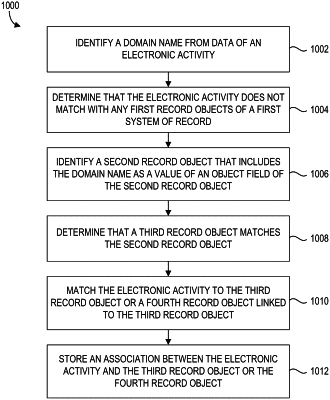| CPC G06F 16/2455 (2019.01) [G06F 16/21 (2019.01)] | 20 Claims |

|
1. A method comprising:
identifying, by one or more processors, a domain name from data of an electronic activity accessed from a first data source provider;
determining, by the one or more processors, that the electronic activity does not match with any first record objects of a first system of record corresponding to the first data source provider using the domain name, wherein the first system of record is a first local system of record maintained in one or more data structures and generated by the one or more processors using data obtained from a first client system of record of the first data source provider;
responsive to the determination that the electronic activity does not match with any first record objects of the first system of record using the domain name, identifying, by the one or more processors, from a plurality of second record objects included in the at least one second system of record of the at least one second data source provider, a second record object that includes the domain name as a value of an object field of the second record object, wherein the at least one second system of record is at least one second local system of record maintained in the one or more data structures and generated by the one or more processors using data obtained from at least one second client system of record of the at least one second data source provider;
identifying, by the one or more processors, from the second record object, one or more second object field-value pairs of the second record object that do not include the domain name as a value;
determining, by the one or more processors, that a third record object from the first system of record matches with the second record object of the at least one second system of record using the one or more second object field-value pairs of the second record object that do not include the domain name as a value;
matching, by the one or more processors, the electronic activity to the third record object or a fourth record object of the first system of record linked to the third record object responsive to the determination that the third record object of the first system of record matches with the second record object of the second system of record; and
storing, by the one or more processors, in one or more data structures, an association between the electronic activity and the third record object of the first system of record or the fourth record object of the first system of record.
|